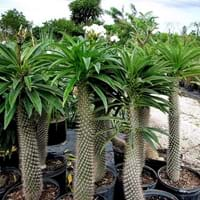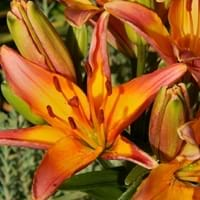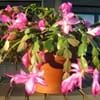Life Span
Perennial
Perennial
Type
Cactus or Succulent, Ornamental Plants, Perennial
Bulb or Corm or Tuber
Origin
Madagascar
Hybrid origin
Types
P. ambongense P. baronii P. bicolor P. bispinosum P. brevicaule P. cactipes P. decaryi P. densiflorum P. eburneum P. geayi P. gracilius
Not available
Number of Varieties
Not Available
Habitat
Rocky areas, Tropical areas
subtropical regions, Temperate Regions
USDA Hardiness Zone
9-12
4-8
Sunset Zone
H1, H2, 13, 21, 22, 23, 24
21,22
Habit
Upright/Erect
Upright/Erect
Flower Color
White
Gold, Pink
Flower Color Modifier
Not Available
Bicolor
Fruit Color
Gray Green, Tan
Green, Brown
Leaf Color in Spring
Green, Dark Green
Green, Dark Green
Leaf Color in Summer
Green, Dark Green
Light Green
Leaf Color in Fall
Dark Green
Several shades of Green
Leaf Color in Winter
Not Available
Light Green
Leaf Shape
Long Narrow
Lanceolate
Plant Season
Spring, Summer, Fall, Winter
Spring, Summer
Sunlight
Full Sun
Full Sun, Partial Sun
Growth Rate
Medium
Medium
Type of Soil
Sand
Clay, Loam, Sand
The pH of Soil
Acidic, Neutral, Alkaline
Acidic, Neutral
Soil Drainage
Well drained
Well drained
Bloom Time
Late Spring, Early Summer, Summer
Early Summer, Summer
Tolerances
Drought
Drought
Where to Plant?
Container, Ground, Pot
Ground, Pot
How to Plant?
Seedlings, Stem Cutting
Bulbs
Plant Maintenance
Medium
Medium
Watering Requirements
Drought Tolerant, Reduce watering in winter
Average Water Needs
In Summer
Lots of watering
Lots of watering
In Spring
Moderate
Moderate
In Winter
Average Water
Average Water
Soil pH
Acidic, Neutral, Alkaline
Acidic, Neutral
Soil Type
Loam, Moist, Sand, Well drained
Clay, Loam, Sand
Soil Drainage Capacity
Well drained
Well drained
Sun Exposure
Full Sun
Full Sun, Partial Sun
Pruning
Prune in winter, Prune to stimulate growth, Remove damaged leaves, Remove dead branches, Remove dead leaves
Remove damaged leaves, Remove dead branches, Remove dead leaves
Fertilizers
All-Purpose Liquid Fertilizer, Fertilize in early spring, fertilize in early summer
All-Purpose Liquid Fertilizer
Pests and Diseases
Aphids, Dry root rot
Red blotch
Plant Tolerance
Drought
Drought
Flower Petal Number
Single
Single
Fragrant Bark/Stem
Not Available
No
Foliage Texture
Bold
Medium
Foliage Sheen
Glossy
Glossy
Attracts
Not Available
Hummingbirds
Allergy
poisonous if ingested, Toxic
Not Available
Aesthetic Uses
along a porch, deck or patio, Beautification, Borders, Showy Purposes
Beautification, Bouquets
Beauty Benefits
Not Available
Not Available
Edible Uses
Not Available
No
Environmental Uses
Air purification
Air purification
Medicinal Uses
Not Available
Not Available
Part of Plant Used
Not Applicable
Flowers
Other Uses
Decoration Purposes, Showy Purposes
Showy Purposes
Used As Indoor Plant
Sometimes
No
Used As Outdoor Plant
Yes
Yes
Garden Design
Container, Feature Plant, Mixed Border, Rock Garden, Wall, Tropical
Container, Cutflower, Feature Plant, Mixed Border
Botanical Name
PACHYPODIUM lamerei
LILIUM 'Ladylike'
Common Name
Madagascar Palm, Club Foot
Asiatic Lily, Ladylike Lily
In Hindi
Madagascar palm
Ladylike lily
In German
Madagaskarpalme
Ladylike lily
In French
Pachypodium de Madagascar
Ladylike lily
In Spanish
Palma de Madagascar
Ladylike lily
In Greek
Pachypodium
Ladylike lily
In Portuguese
Palmeirinha-de-madagáscar, Palmeira-de-madagáscar
Ladylike lily
In Polish
Pachypodium
Ladylike lily
In Latin
Mandacaru
Ladylike lily
Phylum
Magnoliophyta
Not Available
Class
Dicotyledonae
Liliopsida
Order
Gentianales
Liliales
Family
Apocynaceae
Liliaceae
Clade
Angiosperms, Asterids, Eudicots
Angiosperms, Monocots
Tribe
Malouetieae
Not Available
Subfamily
Apocynoideae
Not Available
Difference Between Madagascar palm and Ladylike Lily
If you are confused whether Madagascar palm or Ladylike Lily are same, here are some features about those plants to help you choose better. Many people think that these two plants have the same characteristics, but one can see Madagascar palm and Ladylike Lily Information and learn more about it. Fertilizers required for proper growth of Madagascar palm are All-Purpose Liquid Fertilizer, Fertilize in early spring and fertilize in early summer, whereas for Ladylike Lily fertilizers required are All-Purpose Liquid Fertilizer. Hence, one should know the basic difference between Madagascar palm and Ladylike Lily if you are planning to have them in your garden to enhance its beauty.
<
Flowering PlantsImportance of Madagascar palm and Ladylike Lily
Want to have the most appropriate plant for your garden? You might want to know the importance of Madagascar palm and Ladylike Lily. Basically, these two plants vary in many aspects. Compare Madagascar palm and Ladylike Lily as they differ in many characteristics such as their life, care, benefits, facts, etc. Every gardener must at least have the slightest clue about the plants he wants to plant in his garden. Compare their benefits, which differ in many ways like facts and uses. The medicinal use of Madagascar palm is Not Available whereas of Ladylike Lily is Not Available. Madagascar palm has beauty benefits as follows: Not Available while Ladylike Lily has beauty benefits as follows: Not Available.
Compare Facts of Madagascar palm vs Ladylike Lily
How to choose the best garden plant for your garden depending upon its facts? Here garden plant comparison will help you to solve this query. Compare the facts of Madagascar palm vs Ladylike Lily and know which one to choose. As garden plants have benefits and other uses, allergy is also a major drawback of plants for some people. Allergic reactions of Madagascar palm are poisonous if ingested and Toxic whereas of Ladylike Lily have Not Available respectively. Having a fruit bearing plant in your garden can be a plus point of your garden. Madagascar palm has no showy fruits and Ladylike Lily has no showy fruits. Also Madagascar palm is not flowering and Ladylike Lily is not flowering . You can compare Madagascar palm and Ladylike Lily facts and facts of other plants too.





